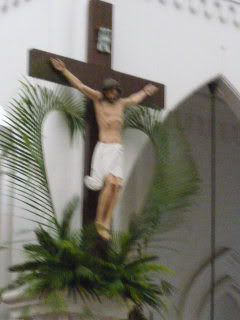
My Christmas tree this year!
The one about Xmas is very interesting! I have always hated when people put Xmas instead of Christmas and always will, but here is why it started....
Xmas
This abbreviation for Christmas is of Greek origin. The word for Christ in Greek is Xristos. During the 16th century, Europeans began using the first initial of Christ's name, "X" in place of the word Christ in Christmas as a shorthand form of the word. Although the early Christians understood that X stood for Christ's name, later Christians who did not understand the Greek language mistook "Xmas" as a sign of disrespect.
More interesting things...
The Christmas Tree
The Christmas Tree originated in Germany in the 16th century. It was common for the Germanic people to decorate fir trees, both inside and out, with roses, apples, and colored paper. It is believed that Martin Luther, the Protestant reformer, was the first to light a Christmas tree with candles. While coming home one dark winter's night near Christmas, he was struck with the beauty of the starlight shining through the branches of a small fir tree outside his home. He duplicated the starlight by using candles attached to the branches of his indoor Christmas tree. The Christmas tree was not widely used in Britain until the 19th century. It was brought to America by the Pennsylvania Germans in the 1820's.
Christmas Lights
The appeal of the Christmas light is often likened to the starts in the sky, or the glisten of freshly fallen snow in the moonlight. Early Christmas lights were not quite as safe as today's light strings. Candles were used in trees inside the home, and lit in windows. Hot flames and live trees were not the safest mix, but the temptation to add lights to Christmas decorating was too strong to curb. Many factors have contributed to the widespread use of Christmas lights, including lighting contests promoted by manufacturers, war propaganda using holidays as an opportunity to bond the nation, and local celebrations across the country to try and start traditions of hope and peace. Light strings are now found in all shapes, sizes, and colors, as well as in cool-to-the-touch LEDs.
Poinsettias
Poinsettias are native to Mexico. They were named after America's first ambassador to Mexico, Joel Poinsett. He brought the plants to America in 1828. The Mexicans in the eighteenth century thought the plants were symbolic of the Star of Bethlehem. Thus the Poinsettia became associated with the Christmas season. The actual flower of the poinsettia is small and yellow. But surrounding the flower are large, bright red leaves, often mistaken for petals.
The Date of Christmas
The idea to celebrate Christmas on December 25 originated in the 4th century. The Catholic Church wanted to eclipse the festivities of a rival pagan religion that threatened Christianity's existence. The Romans celebrated the birthday of their sun god, Mithras during this time of year. Although it was not popular, or even proper, to celebrate people's birthdays in those times, church leaders decided that in order to compete with the pagan celebration they would themselves order a festival in celebration of the birth of Jesus Christ. Although the actual season of Jesus' birth is thought to be in the spring, the date of December 25 was chosen as the official birthday celebration as Christ's Mass so that it would compete head on with the rival pagan celebration. Christmas was slow to catch on in America. The early colonists considered it a pagan ritual. The celebration of Christmas was even banned by law in Massachusetts in colonial days.
Mistletoe and Holly
Two hundred years before the birth of Christ, the Druids used mistletoe to celebrate the coming of winter. They would gather this evergreen plant that is parasitic upon other trees and used it to decorate their homes. They believed the plant had special healing powers for everything from female infertility to poison ingestion. Scandinavians also thought of mistletoe as a plant of peace and harmony. They associated mistletoe with their goddess of love, Frigga. The custom of kissing under the mistletoe probably derived from this belief. The early church banned the use of mistletoe in Christmas celebrations because of its pagan origins. Instead, church fathers suggested the use of holly as an appropriate substitute for Christmas greenery.

















No comments:
Post a Comment